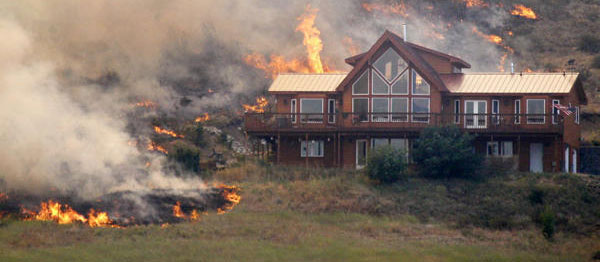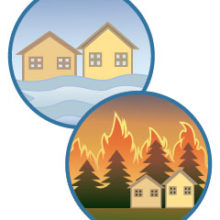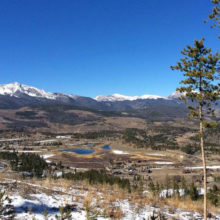- Every community studied, whether rural or more densely populated, had significant amounts of WUI residential growth, a relatively recent large fire, and remains at high risk from wildfires.
- The case studies highlight that western communities are struggling to respond to dangers from future wildfires.
- Eight lessons and two policy recommendations emerged for how to enhance public safety and reduce future suppression costs.

Case Studies and Lessons Learned
As wildfires worsen across the West, Headwaters Economics is researching the relationship between residential development in the Wildland-Urban Interface (WUI) and escalating expenses from protecting lives and property.
As part of this work, we sought to better understand whether and how communities are altering the way they confront wildfire risk, and to extract useful lessons and public policy insights.
The resulting report (PDF) is based on eight case studies of cities and counties throughout the western United States.
Background
We studied communities that reflect the geographic diversity of the West and a mix of rural and more densely populated areas. These communities all have had significant amounts of residential growth in the WUI, have experienced a relatively recent large fire that would potentially spur them to act on reducing wildfire risks, and remain at high risk from wildfires.
We included communities that we had heard were actively implementing solutions to wildfire risk as well as those that were simply staying the course—because of lack of resources, lack of political will, or any number of other reasons—even after experiencing severe fires.
While not an exhaustive list, we believe the communities studied are representative of typical jurisdictions and their responses to wildfire threats across the West.
Communities Studied
We studied eight communities across the West:
- Boulder County, CO
- La Plata County, CO
- City of Flagstaff, AZ
- El Dorado County, CA
- Kittitas & Okanogan counties, WA
- Missoula & Ravalli counties, MT
- City of Jackson, WY
- City of Santa Fe, NM
Lessons
The case studies highlight that western communities are doing little to respond to dangers from future wildfires—compared to what they would need to do to enhance public safety and reduce future suppression costs.
Eight specific lessons emerged:
- Lack of local resources is a significant obstacle. Many counties and towns have all-volunteer fire departments (except for a few paid positions). Limited staff curtails fire prevention and education efforts, monitoring compliance, and firefighting capacity. In at least three of the counties we examined (Okanogan, Missoula, and Ravalli), the bulk of firefighters and fire personnel are volunteer. Many staff emphasized the heavy burden this creates and the consequences on their ability to do initial fire prevention work and then sustain it over time.Limited financial resources also mean that many rural counties do not have a fire marshal. Okanogan and Kittitas counties demonstrate a clear contrast between comparable counties—one county with a fire marshal, who has been able to enact fire codes; and one county without an official, where little has been done to reduce wildfire risk.
- Lack of local political will may be as significant as lack of resources. Often the anti-regulatory sentiments in a community are strong enough to impede enacting regulations or implementing basic enforcement actions, such as hiring a fire marshal, even if the community has sufficient financial resources. Ravalli County, for example, is a relatively wealthy county, but is hesitant to enact regulations of any kind, not just WUI development. Even localities like Boulder, which have successfully enacted and enforced some regulations, such as open space requirements, are reluctant to introduce the idea of land use planning as a solution to wildfire risk and costs.
- A high level of cooperation among government bodies is important. Cooperative agreements between local, county, state and federal agencies create efficiencies and allow parties to delineate more clearly their responsibilities and share information. Such coordination and cooperation translates into high levels of trust and long-standing relationships—like those in Kittitas and Missoula counties or Jackson, Wyoming where the city and Teton County planning departments are working together.
- Education is essential to overcome denial and complacency. Education about fire risk, fire behavior, and the limitations of firefighting can help counteract people’s capacity to deny unpleasant information or believe that disasters only happen to other people. Often a fire close to home is what it takes to raise awareness and trigger action, but by then it may be too late. Under certain fire conditions, aggressive firefighting and good coordination may save lives and structures. But such successes can also lull communities into thinking that aggressive firefighting will always be able to save their homes, as Jackson’s example illustrates.
- How wildfire risk is presented is critical to gaining support. Politics, education, and experience all play a role in how communities receive information about wildfire risk and react to prevention strategies. In Missoula, for example, county officials are careful to focus on the importance of saving lives, rather than the need for regulations. In Flagstaff, science-based evidence about forest fires and forest health, as well as on-the-ground examples of fuel treatments, have been effective in helping residents understand and respond to wildfire risk.
- It is impossible to be continually “Firewise” or fire safe. Being fire safe is important but it is not the same as being fire proof. Creating a buffer between forest and homes requires constant work and vigilance. The communities we studied struggled to maintain a true barrier between residences and forest fuels. The recent wildfire near Colorado Springs, where many residents incorrectly believed they were safe from fire, is instructive. While many communities encourage Firewise activities, few require and enforce them.
- WUI development restricts forest management options. The presence of homes near public lands restricts the way the Forest Service can manage the forest. More aggressive fuel treatments and fire suppression techniques—such as prescribed burns and large backburn areas—are risky when homes are nearby. They also involve more risk for firefighters and agencies, who can be blamed for a decision that does not play out well, such as the recent Montana Supreme Court ruling that a state agency’s backfire unnecessarily harmed a private ranch.
- Fuel treatments are critical, but implementing them in the WUI is not enough. To effectively reduce the severity of wildfires, fuel reduction must be done deeper in the forest as well as near development. While this is primarily the responsibility of the Forest Service, bond measures that support forest thinning, such as in Flagstaff, can help counteract funding deficiencies. In addition, reducing the need for Forest Service resources to protect WUI homes leaves more resources for fuel treatment deeper in the forest.
Policy Implications
Until communities accept that wildfires are a large and growing risk, they are unlikely to provide sufficient resources to address this issue proactively and comprehensively.
Because local conditions are unlikely to change in the near future—meaning that wildfire dangers will not be addressed sufficiently in most communities—policy makers should look to reform federal and state policies that provide incentives for cities and counties to take action. The two broad policy reforms described below would work best in concert, making more resources and tools available to communities while also increasing community accountability.
- Federal assistance should be better targeted to reduce future fire costs and risks. To date, federal assistance to counties has been limited mostly to fuels reduction, but much more could be done with land use planning, education, risk mapping, and other tools. Overall federal funding is likely to decrease in coming years, so new policies should focus on what is known to be most effective in the near term—limiting future building in the WUI.
- Cost responsibility must shift from the federal government to local jurisdictions. At the same time, the federal government should strongly consider increasing local cost responsibility for fire suppression. Too often, communities—despite rising risks—have opted to take no action or approved new unsafe residential development in the WUI, even after recent nearby fires caused extensive home loss and other costs.Shifting a higher portion of the costs related to the defense of homes to local governments would place a greater burden on these communities, but may be necessary to create the incentive or political will for local leaders and officials to take action. This does not necessarily mean no building, but it may mean local governments change how and where they approve future subdivisions. Local planning departments should be given the authority to pursue efforts such as requiring¬ that new homes are built out of harm’s way, or that residences must be clustered as part of subdivision approval. If communities are reluctant to pass strict regulations, other more flexible options—such as providing bonuses to developers who reduce wildfire liabilities—also are available.


